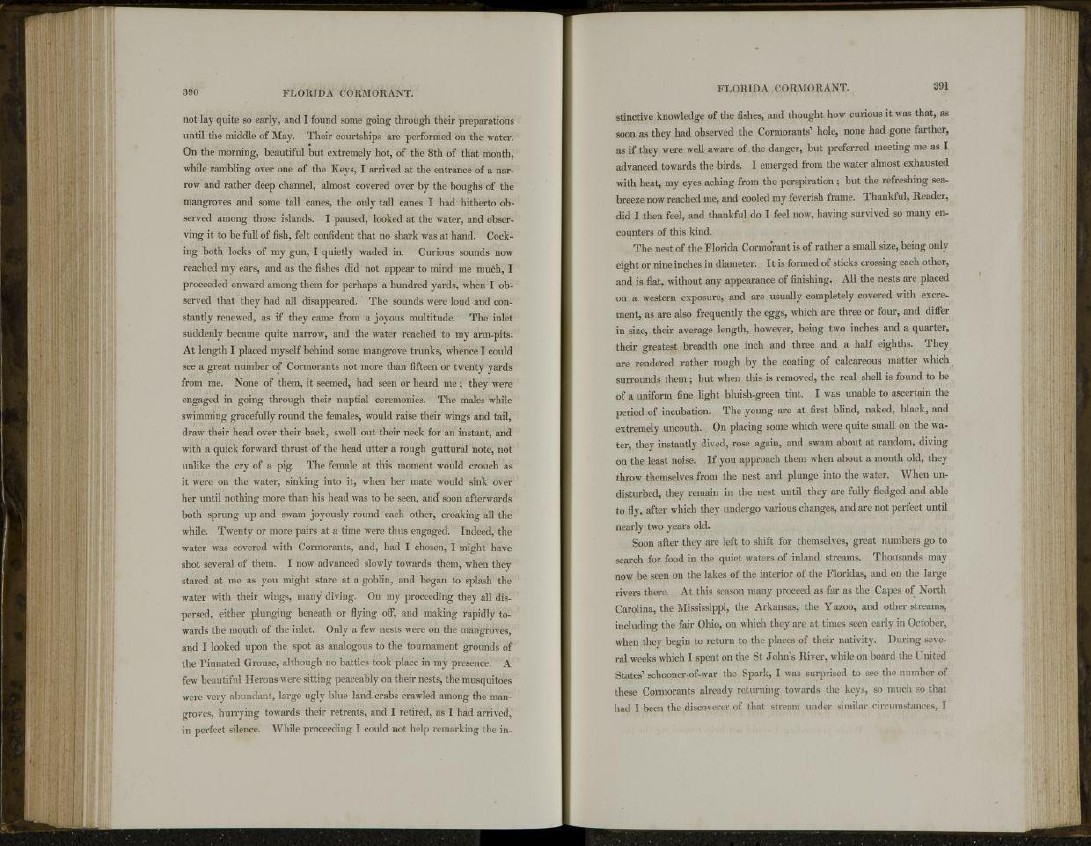
not lay quite so early, and I found some going through their preparations
until the middle of May. Their courtships are performed on the water.
On the morning, beautiful but extremely hot, of the 8th of that month,
while rambling over one of the Keys, I arrived at the entrance of a narrow
and rather deep channel, almost covered over by the boughs of the
mangroves and some tall canes, the only tall canes I had hitherto observed
among those islands. I paused, looked at the water, and observing
it to be full of fish, felt confident that no shark was at hand. Cocking
both locks of my gun, I quietly waded in. Curious sounds now
reached my ears, and as the fishes did not appear to mind me much, I
proceeded onward among them for perhaps a hundred yards, when I observed
that they had all disappeared. The sounds were loud and constantly
renewed, as if they came from a joyous multitude. The inlet
suddenly became quite narrow, and the water reached to my arm-pits.
At length I placed myself behind some mangrove trunks, whence I could
see a great number of Cormorants not more than fifteen or twenty yards
from me. None of them, it seemed, had seen or heard me ; they were
engaged in going through their nuptial ceremonies. The males while
swimming gracefully round the females, would raise their wings and tail,
draw their head over their back, swell out their neck for an instant, and
with a quick forward thrust of the head utter a rough guttural note, not
unlike the cry of a pig. The female at this moment would crouch as
it were on the water, sinking into it, when her mate would sink over
her until nothing more than his head was to be seen, and soon afterwards
both sprung up and swam joyously round each other, croaking all the
while. Twenty or more pairs at a time were thus engaged. Indeed, the
water was covered with Cormorants, and, had I chosen, I might have
shot several of them. I now advanced slowly towards them, when they
stared at me as you might stare at a goblin, and began to splash the
water with their wings, many diving. On my proceeding they all dispersed,
either plunging beneath or flying off, and making rapidly towards
the mouth of the inlet. Only a few nests were on the mangroves,
and I looked upon the spot as analogous to the tournament grounds of
the Pinnated Grouse, although no battles took place in my presence. A
few beautiful Herons were sitting peaceably on their nests, the musquitoes
were very abundant, large ugly blue land-crabs crawled among the mangroves,
hurrying towards their retreats, and I retired, as I had arrived,
in perfect silence. While proceeding I could not help remarking the instinctive
knowledge of the fishes, and thought how curious it was that, as
soon as they had observed the Cormorants' hole, none had gone farther,
as if they were well aware of the danger, but preferred meeting me as I
advanced towards the birds. I emerged from the water almost exhausted
with heat, my eyes aching from the perspiration ; but the refreshing seabreeze
now reached me, and cooled my feverish frame. Thankful, Reader,
did I then feel, and thankful do I feel now, having survived so many encounters
of this kind.
The nest of the Florida Cormorant is of rather a small size, being only
eight or nine inches in diameter. It is formed of sticks crossing each other,
and is flat, without any appearance of finishing. All the nests are placed
on a western exposure, and are usually completely covered with excrement,
as are also frequently the eggs, which are three or four, and differ
in size, their average length, however, being two inches and a quarter,
their greatest breadth one inch and three and a half eighths. They
are rendered rather rough by the coating of calcareous matter which
surrounds them ; but when this is removed, the real shell is found to be
of a uniform fine light bluish-green tint. I was unable to ascertain the
period of incubation. The young are at first blind, naked, black, and
extremely uncouth. On placing some which were quite small on the water,
they instantly dived, rose again, and swam about at random, diving
on the least noise. If you approach them when about a month old, they
throw themselves from the nest and plunge into the water. When undisturbed,
they remain in the nest until they are fully fledged and able
to fly, after which they undergo various changes, and are not perfect until
nearly two years old.
Soon after they are left to shift for themselves, great numbers go to
search for food in the quiet waters of inland streams. Thousands may
now be seen on the lakes of the interior of the Floridas, and on the large
rivers there. At this season many proceed as far as the Capes of North
Carolina, the Mississippi, the Arkansas, the Yazoo, and other streams,
including the fair Ohio, on which they are at times seen early in October,
when they begin to return to the places of their nativity. During several
weeks which I spent on the St Johns River, while on board the United
States1 schooner-of-war the Spark, I was surprised to see the number of
these Cormorants already returning towards the keys, so much so that
had I been the discoverer of that stream under similar circumstances, I